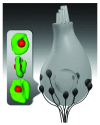New insights into cochlear sound encoding
- PMID: 27635230
- PMCID: PMC5007750
- DOI: 10.12688/f1000research.8924.1
New insights into cochlear sound encoding
Abstract
The inner ear uses specialized synapses to indefatigably transmit sound information from hair cells to spiral ganglion neurons at high rates with submillisecond precision. The emerging view is that hair cell synapses achieve their demanding function by employing an unconventional presynaptic molecular composition. Hair cell active zones hold the synaptic ribbon, an electron-dense projection made primarily of RIBEYE, which tethers a halo of synaptic vesicles and is thought to enable a large readily releasable pool of vesicles and to contribute to its rapid replenishment. Another important presynaptic player is otoferlin, coded by a deafness gene, which assumes a multi-faceted role in vesicular exocytosis and, when disrupted, causes auditory synaptopathy. A functional peculiarity of hair cell synapses is the massive heterogeneity in the sizes and shapes of excitatory postsynaptic currents. Currently, there is controversy as to whether this reflects multiquantal release with a variable extent of synchronization or uniquantal release through a dynamic fusion pore. Another important question in the field has been the precise mechanisms of coupling presynaptic Ca (2+) channels and vesicular Ca (2+) sensors. This commentary provides an update on the current understanding of sound encoding in the cochlea with a focus on presynaptic mechanisms.
Keywords: inner hair cell; otoferlin; synaptic ribbon.
Conflict of interest statement
The authors declare that they have no competing interests. No competing interests were disclosed. No competing interests were disclosed.
Figures

References
-
- Rutherford MA, Moser T: The Ribbon Synapse Between Type I Spiral Ganglion Neurons and Inner Hair Cells. In The Primary Auditory Neurons of the Mammalian Cochlea, (Springer Verlag, New York, Berlin, Heidelberg),2016;52:117–156. 10.1007/978-1-4939-3031-9_5 - DOI
Publication types
LinkOut - more resources
Full Text Sources
Other Literature Sources

